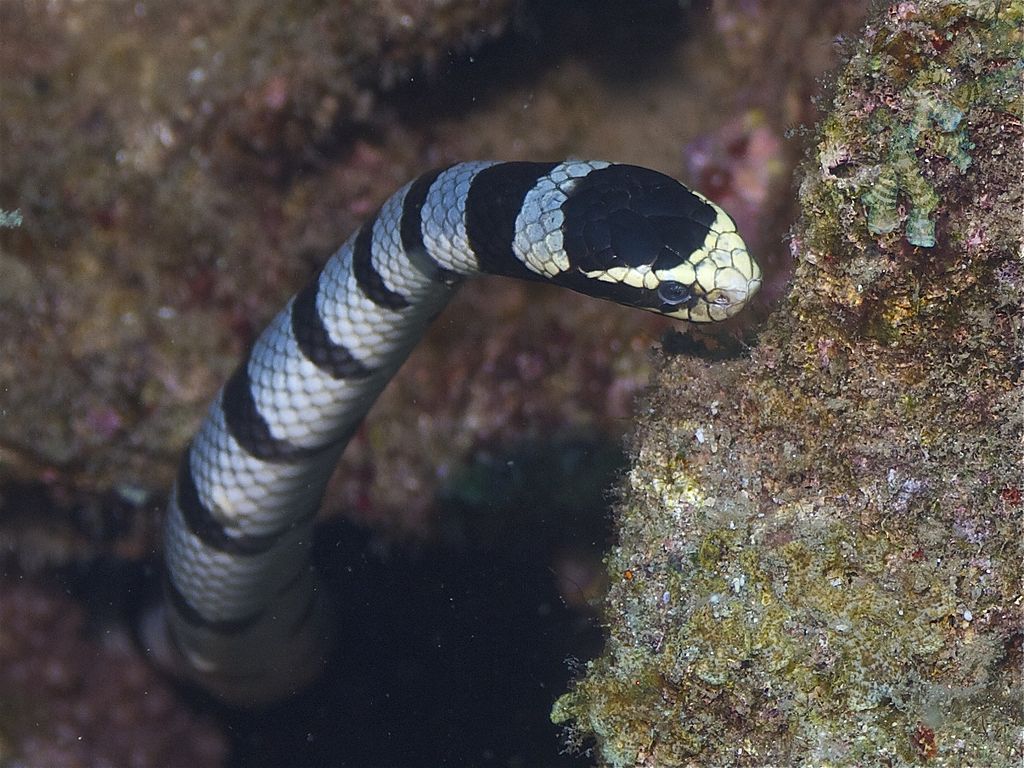Zoltan Takacs’s venomous vision
Toxin researcher mines snake DNA for potential medicines
Peter Hess • September 28, 2015

Sea Kraits like this one can deliver many times the amount of venom needed to kill a human. [Image credit: Elias Levy]
Snake venom isn’t just toxic to Zoltan Takacs; it sends him into anaphylactic shock. He’s even allergic to the antivenom. For most people this wouldn’t be a problem, but Takacs studies venomous snakes. He travels the world collecting venom samples for their potential value as pharmaceutical compounds, dodging venomous fangs wherever he goes.
The Hungarian-born toxinologist and adventurer has been featured in National Geographic, among other major publications, and is obviously comfortable in the spotlight. Speaking Sept. 14 at the Explorers Club in New York City, he took the lectern after a slick introductory video showed him catching sea snakes with his hands.
“I’m very much impressed with how many snake catchers are in New York City,” Takacs joked in his thickly accented, gravelly voice, eliciting laughter and applause from the crowd.
An adventurer himself, Takacs regaled the audience with stories of the exotic locales his venom research has taken him to over the years. From puff adders in Yemen to bushmasters in the Amazon, from sea kraits in clear Pacific waters to Gaboon vipers in steamy African jungles, he has encountered a huge range of venomous snakes in his search for drug leads.
Takacs described how animal toxins have evolved over millions of years to latch on to the receptors of victims’ cells, “like a key would fit into a lock.” Since these toxins only bind to specific receptors, researchers like Takacs see a potential to use them in pharmaceuticals. They envision drugs that will, like their parent toxins, bind only to receptors associated with the condition the drug is intended to treat. This could minimize side effects.
There were no empty seats in the room adorned with relics from adventurers, including a note from Apollo 13 astronaut Jim Lovell apologizing for not being able to bring the Explorers Club flag to the moon. Takacs swung back-and-forth from travelogue to science lecture, giving the audience of mostly non-scientists a break from the data before diving back in to the nuts and bolts of his research.
Takacs uses collected blood and tissue samples to map snake DNA. The map gives him access to information about every toxin contained in a snake venom. “Once you have that genetic blueprint of the toxin, you can put that genetic blueprint into bacteria and reproduce it,” he said, explaining how researchers use genetically modified bacteria to synthesize compounds from the snake toxins. This process allows researchers to replicate toxins without having to capture snakes and extract their venoms.
Useful medicines have already been produced from animal venoms. Eptifibatide, used to help prevent life-threatening coronary blockages in high-risk patients, was synthesized from the venom of the southeastern pygmy rattlesnake. Captopril, used to treat hypertension, was developed from lancehead viper venom. And there are many others.
Yet despite Takacs’s hopes, so far these drugs generally still carry the same litany of side-effects we are accustomed to hearing at the end of pharmaceutical commercials.
The “promise of therapeutics hasn’t really panned out,” says Angel Yanagihara, a venom biochemist at the University of Hawaii. “Frankly, my point of view is that these venoms are not goldmines to be exploited for magic tools that can potentially be reengineered for medical purposes,” Yanagihara said in an interview. She argues that researchers investigating toxins only for drug leads could be missing out on knowledge about diseases and basic biology. “There’s a lot to be learned from studying these venoms, but if we go into it with blinders, looking for pharmaceutical goldmines, that can short-circuit the process.”
Takacs disputes this claim, citing the fact that multiple toxin-derived drugs are on the market. Still, they are not the side-effect-free drugs that have been promised by toxin researchers. He predicts that the landscape will only continue to improve as DNA mapping technology becomes quicker and cheaper. Takacs pins his hope on the fact that toxins have been evolving for millions of years to target key life processes. There exist many animal toxins that have yet to be explored, and recent advances in biotechnology enable this exploration. “There are millions of animal toxins with fascinating evolutionary genetics, natural history, biochemistry, pharmacology, epidemiological and clinical aspects.”
But even if Takacs’s optimistic vision of a new array of safer medicines derived from venoms isn’t yet a reality, he’s convinced that it can happen — unless humanity’s appetite for environmental destruction overwhelms efforts like his own. “If you let this natural beauty to be erased,” Takacs told the crowd, “we’re going to be erasing future potential medications.”
*Correction, September 29, 2015. The following error has been corrected from the originally published version of this story:
It’s not a simple fact that toxins will lead to the answer, but by studying many toxins with advanced DNA screening, scientists might be able to adapt them to drugs.